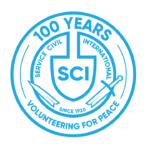A Dream of Peace
The roots of Service Civil International lie in a very practical peace project. After the First World War, Europe had to be reconstructed and the people needed to co-operate again in a peaceful way. In 1920 a small international group gathered to repair a war-torn village on the French and German border. This first action started a movement of international volunteer workcamps and a network called Service Civil International.
Later on the educational aspects of the workcamps and the international exchange became as important as the work itself. Workcamps are seen as a tool for creating intercultural understanding and solidarity between people.
During the years the activities as well as the size of SCI have expanded. Nowadays the work of SCI is done in all continents and varies from reconstruction work to ecology, social inclusion and North-South solidarity. While SCI has become bigger, the structure of the organization has also become more complex. Fortunately the core activities are still the same. Every year, thousands of volunteers can experience the hope of peace becoming reality!
Where did it all start?
International Fellowship of Reconciliation was an organisation of Christian pacifists, who shared the values of non-violence, peace education and inter-religious dialogue. In 1919 they organised an international conference in The Netherlands, trying to define the methods and priorities of their work. All the talking frustrated some participants, who wished to do something more concrete for helping war-torn Europe.
One of the organisers of this conference, a Swiss man named Pierre Ceresole, presented the idea of an international team of volunteers who would work together to repair the damage from the war. By working together in a spirit of friendship, this team would also be a demonstration of international solidarity. It would show that people of different nationalities could refuse to be each other’s enemies. This very same idea still lies in the heart of all activities of Service Civil International.
The first international workcamp was organised in 1920 by Pierre Ceresole and his friends in Verdun, France, next to the German border. Even though the first experience was not easy, the idea spread quickly. The volunteers from this camp wanted to inspire others to work for peace as an alternative to military service. The number of volunteers rose quickly and they also gained support from local people and the governments. They started to call their network Service Civil International.
After the first workcamp
In the 1920’s SCI organised many voluntary projects, concentrating on areas affected by floods and avalanches. During the Spanish civil war many SCI-volunteers were active in helping with the evacuations and practical assistance for the refugees. Active people started also to create their own SCI groups in their home countries and SCI expanded rapidly. This also meant that a more formal structure needed to be created. The volunteer exchange between Europe and Asia had already started as well as the contacts with Eastern Europe and North Africa.
In the 1960’s the way of organising workcamps changed. Besides the work itself, the educational aspects and the international exchange became more important. The movement also became more political. In the 1980’s peace again became the core issue and the East-West work was important in Europe. Also projects around youth and unemployment and North-South issues were of importance and were the starting point for many international working groups.
Then and now
As the years have passed the work of SCI has become more widespread. In the 1990’s SCI worked with almost too many issues: with the war in the Balkans, refugees, ecology, a growing number of East-European partners and North-South exchanges. In the mid 90’s SCI went through structural changes and later developed a Strategic plan for the years 2004-2009. Recently there has been discussion about democracy, efficiency, the meaning of peace work and the role of our organisation. Still every year hundred of people are inspired by the simple, but powerful idea, with which the first workcamp started.

